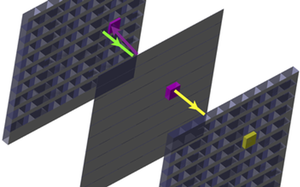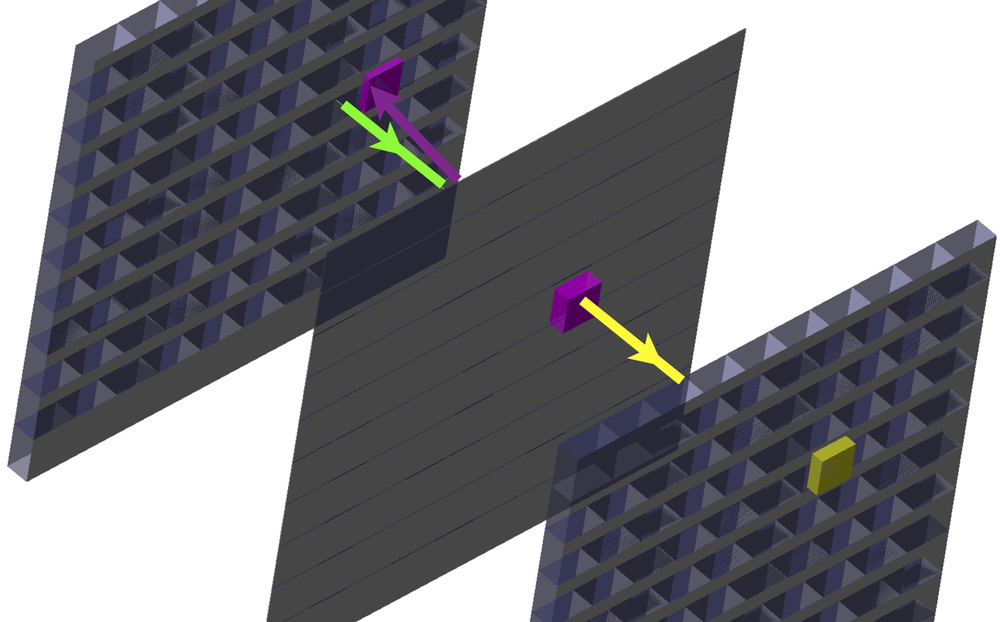A Detector to Track Antineutrinos
Existing detectors for antineutrinos generated by nuclear reactors and by radioactive beta decay are large devices that record only the total number of particles they capture. Now two physicists propose an antineutrino detector that would record the direction in which captured particles were traveling. They hope to build a meter-sized demonstration device that could detect the intense flux of antineutrinos from a nuclear reactor, making it possible to image the reaction’s intensity. A detector able to map the much weaker emission from radioactivity within the Earth would be large but still potentially practical, they say.
The standard method for detecting antineutrinos relies on inverse beta decay: the antineutrino collides with a proton (usually in hydrogen), converting it into a neutron and a positron that fly off at high speed. A typical detector is a large volume of a hydrogen-rich “scintillator” material, loaded with an element, such as boron, that has a propensity for capturing neutrons. The neutron produced by inverse beta decay initially moves roughly in line with the original path of the antineutrino, but it scatters from many nuclei before being captured, erasing its initial direction. The positron slows down roughly in a straight line, within a few centimeters, but the scintillator converts its energy into light that radiates in all directions, obscuring the positron’s path.
Detectors for solar and cosmic neutrinos, such as the gigantic IceCube and Super-Kamiokande installations, can indicate the paths of neutrinos and of high-energy (greater than billion electron volts) antineutrinos. But there are no detectors that provide directional information on antineutrinos with a few million electron volts of energy. Such a detector could image radioactive sources in the Earth or allow detailed studies of nuclear reactors.
Benjamin Safdi of the Massachusetts Institute of Technology and Burkhant Suerfu of Princeton University propose an antineutrino detector with directional capability. They call their design a Segmented AntiNeutrino Tomography Apparatus (SANTA). It divides the detection medium into layers separated by empty space. A neutron created by an antineutrino interaction in the central, “target” layer will escape before scattering—because the layer is thin—preserving its initial direction. Then it will travel through empty space until it hits the thicker “capture” layer, where it generates a reaction that emits a light flash. The neutron’s direction is along a straight line from its capture location back to the antineutrino event (whose location is revealed by the light emission triggered by the positron). The trick is that the neutron travels a long distance through empty space before any interactions.
To test their idea, the team performed simulations in which the target layer was cm, cm, or cm thick and made of plastic scintillator. The capture layers were one meter away, on both sides of the target layer and made of the same scintillator material but augmented by by weight of boron. These layers were cm thick, enough to capture almost all the neutrons.
Safdi and Suerfu performed two types of simulations. In one, they took the antineutrino trajectory to be the same as the neutron’s flight path. That inference, they found, was accurate to only about degrees. In the second case, they assumed that the positron’s path could also be measured in events where it escaped the target layer (not before generating some light to reveal its place of origin) and appeared in one of the capture layers. With information on both particles, the inferred antineutrino trajectory was accurate to within about degrees for a -cm-thick target layer.
A SANTA with layers m on a side could detect a substantial number of events if placed m from a nuclear reactor, Safdi and Suerfu found. They are now working on a proposal to build such a device. Patrick Huber of Virginia Tech in Blacksburg says that the proposed technique is “a very clever idea.” He thinks that a large directional detector to study the Earth’s internal radioactivity would be of great help in understanding where the planet’s heat comes from. Safdi and Suerfu suggest that such a device would be tens of meters across and a kilometer long, but Huber sees no practical reason why it couldn’t be built. “We have the technology,” he says, and “you don’t have to pay for empty space.”
This research is published in Physical Review Letters.
–David Lindley
David Lindley is a freelance science writer in Alexandria, Virginia.





